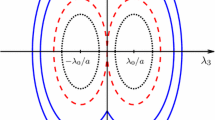Abstract
Different approaches are used to define the optimal path in terms of construction costs. Such problems in practice are usually solved by various heuristic procedures. To obtain a theoretically justified result, one can derive an integral cost functional under certain assumptions and use variational principles. Thus, the classical problem of the calculus of variations is obtained. The necessary condition for the minimum of such a functional has the form of an integrodifferential equation. This paper describes a numerical algorithm for solving this equation, which is based on the prominent shooting method, which has been studied in detail in the literature. Under additional assumptions, the existence of a solution is proved using Schauder’s fixed point principle. The problem of the uniqueness of the solution is studied. A numerical example is provided.

Similar content being viewed by others
REFERENCES
D. Gurara, V. Klyuev, N. Mwase, A. Presbitero, X. C. Xu, and G. Bannister, “Trends and challenges in infrastructure investment in low-income develo** countries,” IMF Working Pap. 2017 (233), 1 (2017). https://doi.org/10.5089/9781484324837.001
C. Saranya, M. Unnikrishnan, S. A. Ali, D. S. Sheela, and V. R. Lalithambika, “Terrain based D* algorithm for path planning,” IFAC-PapersOnLine 49, 178–182 (2016). https://doi.org/10.1016/j.ifacol.2016.03.049
J. Carsten, A. Rankin, D. Ferguson, and A. Stentz, “Global planning on the Mars Exploration Rovers: Software integration and surface testing,” J. Field Rob. 26, 337–357 (2009). https://doi.org/10.1002/rob.20287
S. I. Gass and C. M. Harris, “Dijkstra’s algorithm,” in Encyclopedia of Operations Research and Management Science, Ed. by S. I. Gass and C. M. Harris (Springer, New York, 2001), pp. 19–19. https://doi.org/10.1007/1-4020-0611-X_248
X. **ong, H. Min, Yu. Yu, and P. Wang, “Application improvement of A* algorithm in intelligent vehicle trajectory planning,” Math. Biosci.s Eng. 18, 1–21 (2021). https://doi.org/10.3934/mbe.2021001
P. Sudhakara and V. Ganapathy, “Trajectory planning of a mobile robot using enhanced A-star algorithm,” I-ndian J. Sci. Technol. 9 (41), 1–10 (2016). https://doi.org/10.17485/ijst/2016/v9i41/93816
G. R. Chen and S. Guo, “Convex optimization and A-star algorithm combined path planning and obstacle avoidance algorithm,” Control Decis. 35, 2907–2914 (2020).
S. M. Lavalle, Rapidly-Exploring Random Trees: A New Tool For Path Planning: The Annual Research Report (I-owa State Univ., 1998).
D.-Q. He, H.-B. Wang, and P.-F. Li, “Robot path planning using improved rapidly-exploring random tree algorithm,” in 2018 IEEE Industrial Cyber-Physical Systems (ICPS), St. Petersburg, 2018 (IEEE, 2018), pp. 181–186. https://doi.org/10.1109/icphys.2018.8387656
J. Yi, Q. Yuan, R. Sun, and H. Bai, “Path planning of a manipulator based on an improved P_RRT* algorithm,” Complex Intell. Syst. 8, 2227–2245 (2022). https://doi.org/10.1007/s40747-021-00628-y
S. M. Lavalle and J. J. Kuffner, “RRT-connect: An efficient approach to single-query path planning,” in Proc. 2000 ICRA. Millennium Conf. IEEE Int. Conf. on Robotics and Automation. Symposia Proc. (IEEE, San Francisco, 2000), Vol. 2, pp. 995–1001. https://doi.org/10.1109/ROBOT.2000.844730
L. Jaillet, J. Cortés, and T. Siméon, “Sampling-based path planning on configuration-space costmaps,” IEEE Trans. Rob. 26, 635–646 (2010). https://doi.org/10.1109/tro.2010.2049527
Ya. Li, W. Wei, Yo. Gao, D. Wang, and Z. Fan, “PQ-RRT*: An improved path planning algorithm for mobile robots,” Expert Syst. Appl. 152, 113425 (2020). https://doi.org/10.1016/j.eswa.2020.113425
W. Wang, L. Zuo, and X. Xu, “A learning-based multi-RRT approach for robot path planning in narrow passages,” J. Intell. Robotic Syst. 90, 81–100 (2018). https://doi.org/10.1007/s10846-017-0641-3
M. F. Zazai and A. R. Fügenschuh, “Computing the trajectories for the development of optimal routes,” Optim. Eng. 22, 975–999 (2021). https://doi.org/10.1007/s11081-020-09569-w
J. Yates, X. Wang, and N. Chen, “Assessing the effectiveness of k-shortest path sets in problems of network interdiction,” Optim. Eng. 15, 721–749 (2014). https://doi.org/10.1007/s11081-013-9220-z
J. Bruce and M. M. Veloso, “Real-time randomized path planning for robot navigation,” in RoboCup 2002: Robot Soccer World Cup VI, Ed. by G. A. Kaminka, P. U. Lima, and R. Rojas, Lecture Notes in Computer Science, Vol. 2752 (Springer, Berlin, 2002), pp. 288–295. https://doi.org/10.1007/978-3-540-45135-8_23
D. H. Douglas, “Least-cost path in GIS using an accumulated cost surface and slopelines,” Cartographica: Int. J. Geographic Inf. Geovisualization 31 (3), 37–51 (1994). https://doi.org/10.3138/d327-0323-2jut-016m
D. Tomlin, “Propagating radial waves of travel cost in a grid,” Int. J. Geogr. Inf. Sci. 24, 1391–1413 (2010). https://doi.org/10.1080/13658811003779152
C. Yu, J. Lee, and M. J. Munro-Stasiuk, “Research article: Extensions to least-cost path algorithms for roadway planning,” Int. J. Geogr. Inf. Sci. 17, 361–376 (2003). https://doi.org/10.1080/1365881031000072645
M. E. Abbasov and A. S. Sharlay, “Searching for the cost-optimal road trajectory on the relief of the terrain,” Vestn. S.-Peterb. Univ. Prikl. Mat. Inf. Protsessy Upr. 17 (1), 4–12 (2021). https://doi.org/10.21638/11701/spbu10.2021.101
N. G. Bandurin and N. A. Gureeva, “A method and a software package for numerical solution of the systems of nonlinear ordinary integro-differential-algebraic equations,” Math. Models Comput. Simul. 4, 455–463 (2012). https://doi.org/10.1134/s2070048212050031
N. S. Bakhvalov, N. P. Zhidkov, and G. M. Kobel’kov, Numerical Methods (Laboratoriya Znanii, Moscow, 2020).
B. A. Budak, “Shooting method for solving equilibrium programming problems,” Comput. Math. Math. Phys. 53, 1819–1824 (2013). https://doi.org/10.1134/s0965542513120038
L. A. Lyusternik and V. I. Sobolev, Elements of the Functional Analysis (Nauka, Moscow, 1965).
V. V. Stepanov, Course of the Differential Equations (GIFML, Moscow, 1958).
Funding
The study was supported by the Russian Science Foundation, project no. 23-21-00027, https://rscf.ru/project/23-21-00027/.
Author information
Authors and Affiliations
Corresponding author
Ethics declarations
The authors of this work declare that they have no conflicts of interest.
Additional information
Publisher’s Note.
Pleiades Publishing remains neutral with regard to jurisdictional claims in published maps and institutional affiliations.
Rights and permissions
About this article
Cite this article
Abbasov, M.E., Sharlay, A.S. Variational Approach for Finding the Cost-Optimal Trajectory. Math Models Comput Simul 16, 293–301 (2024). https://doi.org/10.1134/S2070048224020030
Received:
Revised:
Accepted:
Published:
Issue Date:
DOI: https://doi.org/10.1134/S2070048224020030




